One of the most common questions for puppy owners is how big their dog will get, which often leads to wondering when their growth spurts will occur. Knowing when your puppy will grow the most can help you determine their end size, and what to expect during their puppyhood.
It’s important to consider puppy growth as it will affect how much food you should feed them and even whether you should hold off on buying that expensive harness.
Puppy Development Stages Charts
Comparing the growth rate of all of the breeds in the world can be difficult. From a Chihuahua (averaging 4-8 pounds) to an English Mastiff (averaging 200-230 pounds) you will naturally find a great amount of variance.
But there is one thing these breeds will have in common. In their first week of life, they should roughly double in size from their birth weight.
They will then gain between 5-10% each day until around 6-8 weeks of age when they are getting ready to go to their new homes.
Once you bring your puppy home this chart will give you a general estimate of what you can expect.
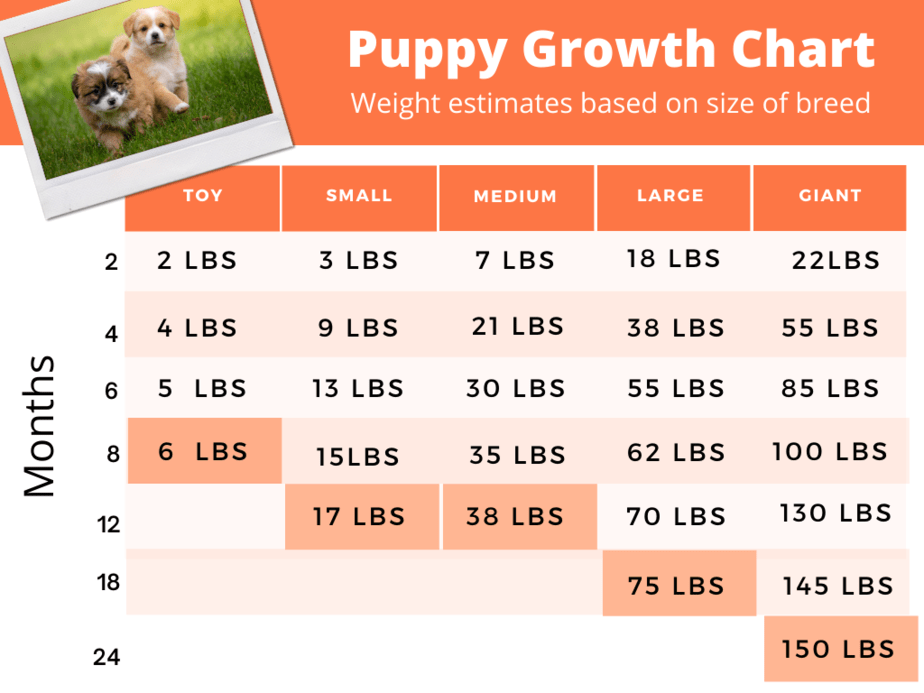
When do small breed puppies grow the most?
Small breed dogs will reach their adult size faster than larger breeds.
All puppies will grow the most between birth and 8-weeks of age. Then growth gradually slows down.
Since small breeds do not grow for as long as their larger counterparts, growth will taper off more quickly. So their weight at two months may double by four months. But then you will see them gain a pound or two per month until they stop growing between 8-12 months of age.
As you can see from this graph, toy and small breeds can start out at similar sizes. But after the steeper growth spurts of months 2-4, there is a larger difference between the two sizes.
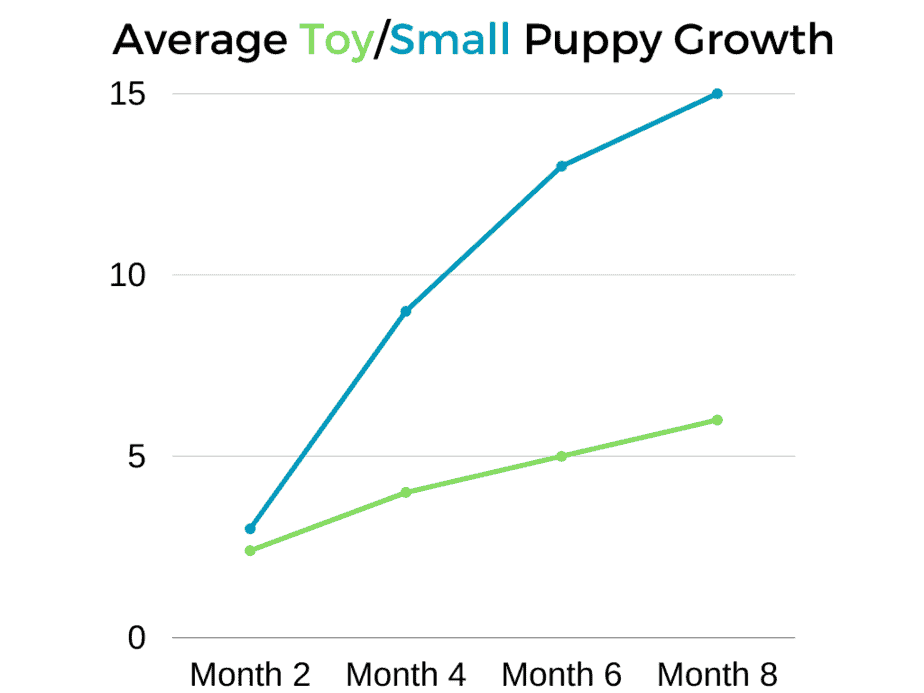
When do large breed puppies grow the most?
The larger the breed (or breeds within your dog’s mix), the longer you will see a steady, faster growth before it tapers off.
For the medium-sized dog it takes about 5-6 months of faster growth and while these breeds will continue to grow until about 12-months of age, the growth rate will slow down.
Large-sized breeds will grow the most until they reach 6-8 months of age. Then their growth rate will slow down. Yet they can continue to grow until about 18-months.
Giants will seem to grow forever! They may nearly double in size every 4-months until about 8-months. Then they will slow down, but they may add another 50% of their body weight by the time they reach 24-months-old.
Here is a graph comparing medium, large, and giant size breeds and their puppy growth rates:
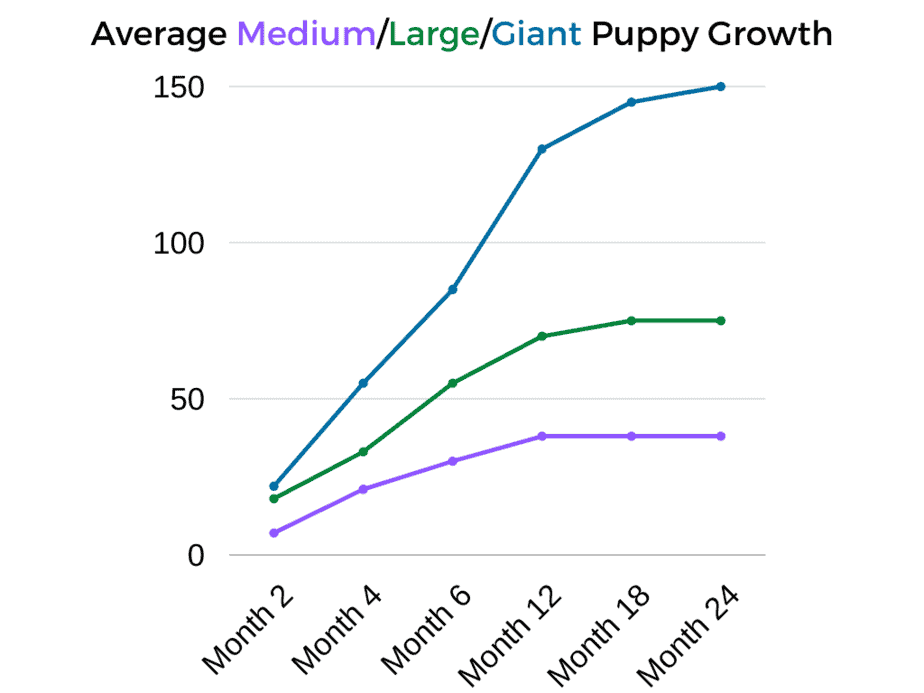
Puppy growth stages
While we often look at the puppy growth stages in regard to emotional development, what is going on with their bodies during this time?
Birth
At birth, puppies have had roughly 9-weeks of development in utero. They are cute little blobs that need their mom and littermates to regulate their body temperature. So they aren’t big or moving around very much.

First Stage: 0 – 3 Weeks
This is also referred to as the neonatal period. As mentioned earlier, in the first week of life, puppies will usually double in size. Because this growth takes a lot of energy, puppies in the neonatal period tend to sleep 90% of the time. Waking up only to take in calories (aka- nurse).
After a fast first week of growth, puppies will increase their body weight by 5-10% each day.
Second Stage: 4 to around 8-12 Weeks
During this period, muscles in the dog’s legs are more developed and they start to play, burning more fuel! But they still continue to gain weight each day if they are healthy.
There are big changes during this period and while they will start to nurse less, they are not ready to be taken away from mom yet.
They should be introduced to kibble soaked in water at this stage, while they gradually wean off mama’s milk.
Third Stage: 2 to 3 months
This is ideally the time they will leave their litters and go into their homes. So this is a big change that often means a change of food and food schedule.
They still should be gaining weight each week. To help them absorb more nutrition from their food, it is often recommended they are offered 3-4 smaller meals per day in their new homes.
If your puppy has soft stool, you will want to check in with your vet, this can decrease the nutrition your dog is absorbing. This can be due to stress of the sudden life changes. And in many cases, this may indicate that you need to try a different food.
A vet checkup will help you rule out that there is not something else going on.
Fourth Stage: 3 to 4(ish) months
If you have a small breed, you will begin to see your puppy’s growth start to taper down. You may see that reflected in their appetite, too.
They may still gain a pound per month for the next few months, but it won’t be as noticeable as it was in months prior.
Larger breeds will still be growing and changing every day. Which means they will still be eating more to keep up with this growth.
Fifth Stage: 4 to 10 months
Brace yourself. You have a teenager! So what does that mean for growth?
For larger dogs that are still growing, you may see growth spurts similar to what we see in teenage humans. Sudden growth spurts may make your puppy seem extra lanky with long limbs. But within the weeks after they gain height, the rest of their body will fill in.
Sixth Stage: 10 to 12 months
Small breeds will be done growing by this stage, with a few exceptions.
And while larger breeds will not be growing as quickly, they will still be growing and filing out.
Seventh Stage: 1+ Years
Small and medium dogs will be done growing by this time, for the most part.
Large dogs may still grow for another 6 months.
Those giant breeds could still have over one year of growth. At this stage, they tend to get their height first, and then their weight will fill out after.
How much can a puppy grow in 2-weeks?
In the first week of life, a puppy’s weight should double. And then they should be gaining 5%-10% of their body weight every day until they reach 6-8 weeks of age.
Once you get them home that growth slows slightly but you should still see an approximate growth rate as displayed in the table below:
| Breed Size | One Week | Two Weeks |
|---|---|---|
| Toy | 5 ounces | 10 ounces |
| Small | 5-8 ounces | 10 ounces – 1 lb. |
| Medium | 1 lb. | 2 lbs. |
| Large | 2 lbs. | 4 lbs. |
| Giant | 2-5 lbs. | 4-10 lbs. |
This rate lasts 4-8 months depending on the size of the breed, with small dogs slowing down earlier.
You may wish to read our post, Should You Choose the Biggest Puppy in the Litter?
Can you tell how big a puppy will get?
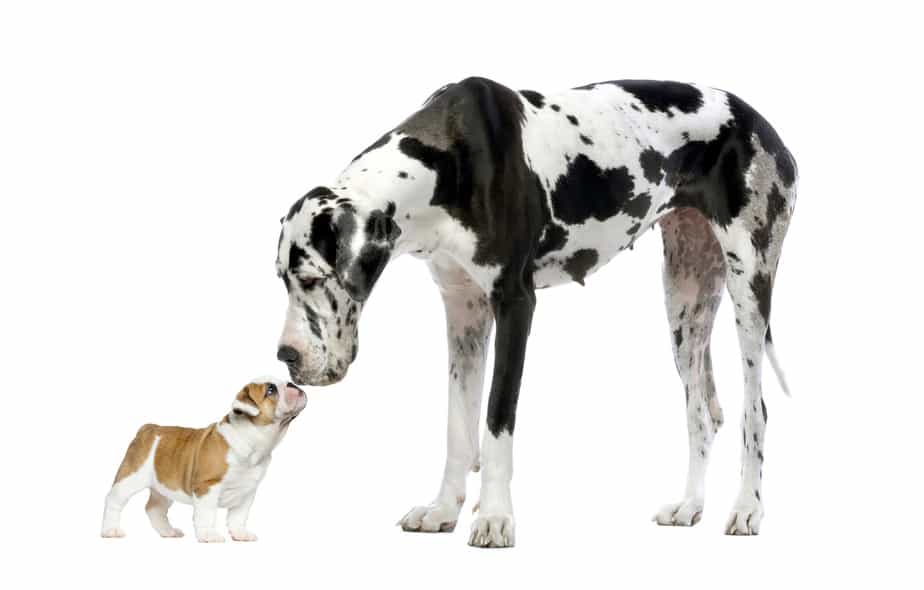
While there is no exact science that can determine the size a puppy will be when all is said and done, there are a few equations that can give you a general estimate.
You have likely heard that paw size will determine the adult size of a puppy, but certain breeds have larger size paws as part of their structure. For instance, Bulldogs tend to have large paws, but are usually medium-sized.
Before you get your puppy there are some things you can consider, besides breed, that may help you guesstimate how much our new family member will grow:
- Is your dog a male or female? Males will usually be slightly larger than their sisters.
- The size of the puppy’s parents. Genetics plays a large role in a puppy’s development so whenever possible, find out the size of your puppy’s parents.
- How big is the litter? Larger litters (based on the breed’s litter norm) will sometimes create smaller puppies.
Once the puppy is in your home you can do the math to see what size they will be:
For toy and small breeds, you can get a rough estimate by taking their weight at 6-weeks-old and double it. Then double it again to get a general idea of their adult weight.
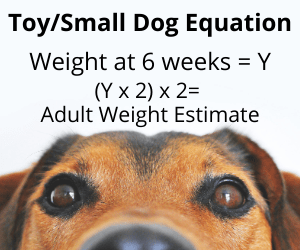
For medium and small breeds, you take their weight at 14-weeks and double it. Then add one-half to that 14-week-old weight.
It is also said that at 6-months, medium and large breeds are around ⅔ of their adult size. So do both equations to get a wider range.
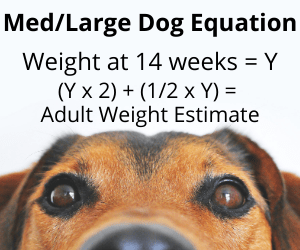
For giant breeds, the formula is a little bit easier. Double their weight at 6-months-old to get a rough estimate of their adult weight.
Remember, these are all estimates. There are outside factors that can affect a dog’s weight such as spaying/neutering, exercise and even nutrition that can also influence how much a puppy will grow.
Final Word
While there is no way of knowing the exact times your puppy will hit a growth spurt, this information should give you a general idea.
Signs that they may show you they’re about to grow are an increase in appetite and sleep.
While watching your puppy’s growth, always be aware that as they grow, their joints and growth plates are also developing. So any joint discomfort should be reported to your vet to avoid long-term issues from getting worse.
Also, if your dog doesn’t seem to be growing at the rate they should, this is also something to bring to your veterinarian’s attention. There are health conditions that can slow down or even halt growth in puppies.
And while you are in the midst of puppyhood, it may seem like your puppy is growing and changing every day. Take the time to enjoy every minute so you can remember this once your dog hits adulthood. It will get here before you know it!
Recall Training Secrets: How to Teach Your Dog Reliable Recall
Teaching a dog recall is not just a basic obedience skill; it's a vital aspect of ensuring the safety and freedom of your beloved pet. Picture this: your dog is playfully chasing after a squirrel [...]
The Joy of Petting: How to Approach Dogs the Right Way
"Can I pet that dog?" is often the first thought that pops into our minds when we see a furry friend wagging its tail. The joy of petting a dog is unmatched, offering both the [...]
Puppy Obedience: Where to Begin? An Introductory Guide
Puppy obedience is more than just teaching commands. It's about nurturing a relationship based on mutual respect and understanding. It lays the foundation for a well-behaved adult dog and ensures a harmonious life together. In [...]
Understanding Canine Autism: Do Dogs Experience It?
Have you ever wondered, can dogs have autism? Autism, a complex condition often characterized by social and communication difficulties, is widely recognized in humans. But when it comes to our canine companions, the idea of [...]








